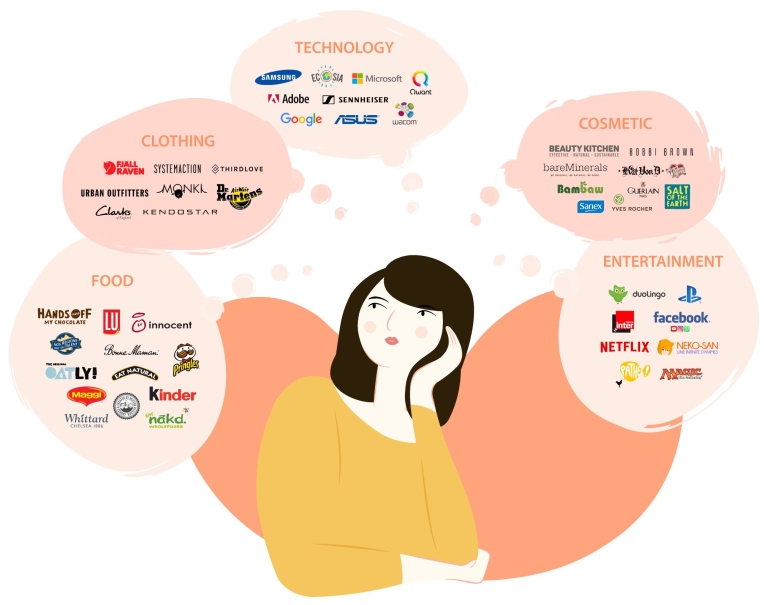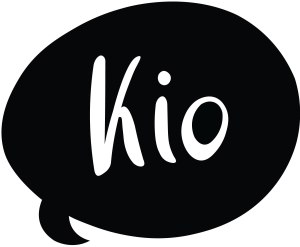Today’s challenge was to look into at all the brands that we buy into and list them. The list is not exhaustive but should include brands within the following categories: food, clothing, cosmetics, entertainment, and service providers. The aim of this challenge is to think and observe how these brands define us as a human being and a consumer.
CONTEXT
According to the Cambridge Dictionary (n.d.), a brand [noun] refers to giving an identity to a product or service made by a particular company. The American Marketing Association (AMA), a brand [noun] is a “name, term, sign, symbol, or design, or a combination of them, intended to identify the goods and services of one seller or group of sellers and to differentiate them from those of competition.” (Keller, 2013). However, marketers in the field of marketing and communication look at a brand [noun] as a marketing tool to increase brand awareness > brand image > brand response > brand resonance, Keller’s Brand Equity Model (Keller, 2013). So, it appears that a brand can either be referred to as a marketing tool or elements creating the identity of a product or service.
From a marketing perspective, brand management refers to the development of a strategic plan to maintain brand equity (the value that a company creates through a product/ service) (Keller, 2013). To create brand equity, a company must make the product/service memorable, easily recognizable, reliable, and having a superior quality than its competitors (Amstrong and Kotler, 2012). In the end, brand management is a tool used to building a consumer strong loyalty, being unique and indispensable in the eyes of the consumer.
Looking at a brand as a verb, the Cambridge Dictionary (n.d.), it is to say that you think someone/ something is a sort of person/ something. Thus, to brand can be regarded as to label or mark someone with something. So, thinking about brands that we are buying into, can it really define who we are as a consumer and as a human individual? Can we label or mark someone after looking at the brands he/she is buying into?
CHALLENGE & REFLECTION
To fulfil this challenge, I listed on a piece of paper all the brands that came into my mind during my recent buying experiences. To sort all these brands, I chose five categories based on the brief which are known as followed: food brands, clothing brands, technology/ IT brands, cosmetic brands, and entertainment brands. These categories represent the best my daily/monthly/yearly product and service consumptions as a consumer. The following illustration provides a summary of my brand list.

For the past 6 years, I became a newly independent consumer, because my parents were no longer paying for my utilities as I started to live by myself. Thus, my journey as a consumer began influenced by my parent’s habit in buying more than we actually need for the sake of ”just in case we don’t have it any more at home”. However, I slowly became aware of my responsibility as a consumer in this society of consumerism. I realised the importance of reducing our consumption to preserve our environment and its eco-system.
Now, when I look for a (new) product or service, I want the brand to be socially responsible and if the brand is, I would be more loyal to this brand than a brand not questioning its moral intentions. In this illustration, these brands are:
- Food brands: Innocent, The Original Oatly, and Nos Régions Ont Du Talent from Leclerc.
- Clothing brands: Fjall Raven, Monki, Dr Martens, and I visit a lot of vintage stores.
- Technology brands: Adobe, Microsoft, Google, Samsung, Ecosia, and Qwant.
- Cosmetic brands: Beauty Kitchen, Kat von D, Bambaw, Salt of the Earth, and Yves Rocher.
Not all the brands in the illustration have been mentioned because they aren’t showing social and/ or environmental engagement. I choose those brands because I think that they are respectful to my body from the inside to the outside but also the environment (recycled clothings, noble material, cruelty-free cosmetics). Again, this aligns with my conviction to reduce my carbon footprint by lowering my consumption of meat and fish (flexitarian), and looking for durable & natural products. In this illustration, these brands are:
- Food brands: Nakd Wholefood and Eat Natural. I visit food markets to buy vegetables & fruits in bulk. I also try to consume seasonable products to reduce my carbon footprint.
- Clothing brand: Thirdlove.
- Technology brands: Asus and Wacom.
- Cosmetic brands: BareMinerals, Bobbi Brown, and Sanex.
The last brands are either bringing back memories or for personal pleasure. This is particularly the case for food brands. Regarding the other brands for clothing, technology and cosmetics, they are a matter of preference and personal taste. Lastly, the entertainment brands can also be divided into different sub-categories like learning, amusement, informative, and social.
- Food brands: HandsOff My Chocolate (pleasure), Whittard (pleasure), Pringles (pleasure), Mister Kitchen (pleasure), Bonne Maman (memories), Kinder (memories), Lu (memories), and Maggi (memories).
- Clothing brands: Urban Outfitters, Clarks, Systemaction and KendoStar.
- Technology brand: Sennheiser.
- Cosmetic brand: Guerlain.
- Entertainment brands: Duolingo (learning), PlayStation (amusement), Netflix (amusement), Neko-san (amusement), Magic Gathering (amusement), France Inter (informative), and Facebook including Instagram, WhatsApp and YouTube(social).
As a consumer, I attach a lot of importance on the brands showing and taking on social and environmental responsibilities. Thus, I would brand myself as someone conscious of its carbon footprint when consuming. However, after reflection, it appears that I am more inclined to close my eyes on these moral values, especially for brands in the food and entertainment sectors. Regarding some of the food brands, I grew up with them and they remind me of memories of my childhood (the madeleine of Proust). The other food brands are my little treat creating a moment of instant pleasure, but these brands could be replaced by alternatives if I looked for them. Regarding the listed entertainment brands, it becomes difficult to find substitutes because they often have a monopoly in the market. The real question is, do I really want to look for these alternatives?
This challenge made us think about our consumer behaviour and observe the brand we are buying into. The illustration shows a brief summary of all the brands that I am consuming. There are many and diverse brands, but it does not mean I am consuming them heavily. Like many other consumers, I am looking into living in a minimalistic lifestyle. A minimalistic lifestyle means living with fewer material possessions and focusing on what’s important, so according to the Minimalists (n.d.), we can find happiness, fulfilment, and freedom.
Looking at my behavioural consumption, I believe that brands will increasingly be called upon to take responsibility for resolving some of the world’s problems such as climate change, preservation of biodiversity, consumerism, human rights, health issues like obesity and malnutrition, food dumping, fake news and many more. More consumers are increasingly looking and wanting brands to be socially responsible (Hesse, 2012). Brands must play a role in encouraging customers to live sustainably.
A tool for (personal) brand analysis
During one of the lectures at UCA, tools were shown, which could be used when conducting a (personal) brand analysis. The Personal Branding Canvas will help us understand and define our Personal Brand.

As mentioned before, a brand is referred to the concept, visuals and perceptions that distinguish one product from others in the same market. When looking at a personal brand analysis, we are looking at how you speak, work, communicate and write creating this identity/ personality that distinguishes you from others. The Personal Branding Canvas is a useful tool to start thinking on how you want to be perceived by others.
A personal brand is having your own voice, a voice that when people hear it, they know it is you! I believe it is important to cultivate our personal brand by determining: what do you wish for people to associate with you when they think of your name? By asking this question, it pushes us to think about our expertise and general qualities. According to Hyde (2014), a strong personal brand is dependent on a strong narrative. In my quest of strengthening my personal brand, I am currently looking into storytelling and illustrative branding, check my Master Project Bibliography.
BIBLIOGRAPHY
Amstrong, G. and Kotler, P. (2012). Principles Of Marketing. 14th edn. New Jersey, USA: Pearson Prentice Hall.
Cambridge Dictionary. (n.d.). Brand [Online]. Available at: Retrieved on October 27, 2018, from https://dictionary.cambridge.org/fr/dictionnaire/anglais/brand (Accessed: 27 October 2018)
Hesse, J. (2012, July 16). Consumers Are Defining Brands [Online]. Available at: https://www.raconteur.net/business-innovation/consumers-defining-brand-values (Accessed: 27 October 2018)
Hyder, S. (2014, August 18). 7 Things You Can Do To Build An Awesome Personal Brand [Online]. Available at: https://www.forbes.com/sites/shamahyder/2014/08/18/7-things-you-can-do-to-build-an-awesome-personal-brand/#55d8e4763c3a (Accessed: 27 October 2018)
Keller, K. L. (2013). Strategic Brand Management, Building, Measuring, and Managing Brand Equity. 4th edn. Harlow, England, UK: Pearson Education.
The Minimalists. (n.d.). What Is Minimalism? [Online]. Available at: https://www.theminimalists.com/minimalism/ (Accessed: 27 October 2018)
